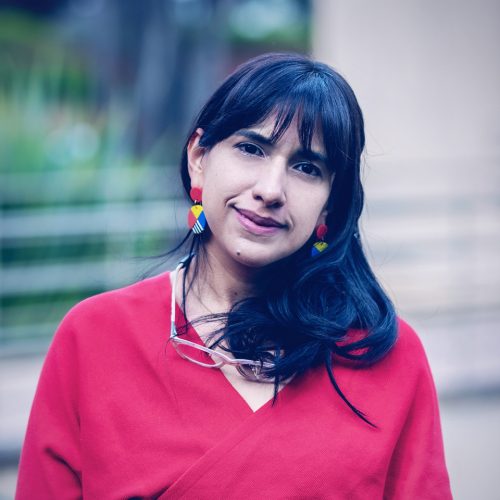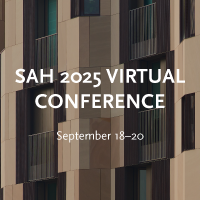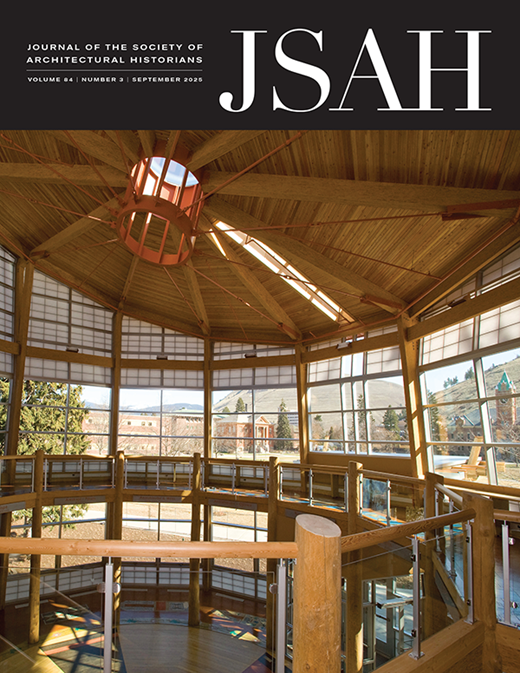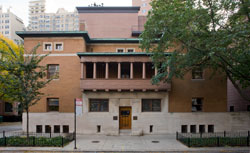-
Membership
Membership
Anyone with an interest in the history of the built environment is welcome to join the Society of Architectural Historians -
Conferences
Conferences
SAH Annual International Conferences bring members together for scholarly exchange and networking -
Publications
Publications
Through print and digital publications, SAH documents the history of the built environment and disseminates scholarship -
Programs
Programs
SAH promotes meaningful engagement with the history of the built environment through its programs -
Jobs & Opportunities
Jobs & Opportunities
SAH provides resources, fellowships, and grants to help further your career and professional life -
Support
Support
We invite you to support the educational mission of SAH by making a gift, becoming a member, or volunteering -
About
About
SAH promotes the study, interpretation, and conservation of the built environment worldwide for the benefit of all
Member Stories: Ingrid Quintana-Guerrero
Sep 2, 2025
by
Olivia Archer

Ingrid Quintana-Guerrero has been a member of SAH for 8 years, and serves as the co-chair of the Latin American Architectural Studies Affiliate Group. She is an Associate Professor in the School of Architecture and Design, Universidad de los Andes, Colombia.
To begin, tell us a little about your background and career path.
I am an architect and architectural historian. I was trained in my home country of Colombia as well as France and Brazil, where I got my PhD.
My biggest challenge is to enhance the study and research of architectural history in a context where the teaching of history has been removed from public schools; therefore, there is skepticism among students regarding its utility for becoming an architect. My research has focused on circulation of actors and ideas across the Americas as a means of shaping architectural education, thinking, and production.
What projects are you currently working on?
I currently am co-directing a project experience with a local research team and a group of scholars in Italy documenting a social-housing neighborhood in Bogota (Colombia), called La Fragua. It was conceived by the local architect Germán Samper at the end of the 1950's, but its construction has been managed by the community. It is a pioneer experience of self-construction and we are interested in documenting not only the physical transformation of the units but the processes that contributed to the consolidation of the social fabric. By doing this, we aim to highlight the heritage values of the neighborhood, tangible and intangible.
I also have been interested in the intersections of architecture, art, and design in the Modern era. I co-curate a research platform called Bauhaus Reverberada, with numerous research products regarding the relationship between the Bauhaus and Latin America.
What's keeping you busy outside of work?
I like to practice sports like kickboxing and swimming. I try to go in the mountains for a hike or dancing once per month. I mostly invest my free time in building meaningful friendships. — I love to try a new coffeeshop with them every time I can — and volunteering in my local community.
Share a particular memory of when you first became aware of architecture, or when you knew you wanted to study its significance.
I'm not quite sure but it probably was when I was 6 and my brother had a fabulous Lego set that I played with. When I was a teenager, I was a huge fan of mangas (Japanese graphic novels) and I admired Japanese architecture. But my definitive contact with architecture was during high school, at my art history classes, receiving lectures on Ancient Greek architecture that I felt in love with.
What interests you most about architectural history?
People. It seems a basic answer but as architectural historians, sometimes we tend to be abstract; to focus more on theories or material matters of architecture, forgetting that people built, dwell in, and shape our built environment.
Who or what has had the biggest influence on your work or career so far?
It is very difficult to mention all the people who have contribute to the scholar I currently am. I really appreciate the advice of those who kindly have pointed to my failures and contributed with constructive criticism. However, my biggest influence are my students because they are at the center of my teaching and research. They are very honest to give me feedback and I learn with and from them on daily basis.
Professional challenges are everywhere. What is your advice for facing them, and perhaps, overcoming them?
Be perseverant. Be humble, ask for help and wise counseling. Also invest time in personal knowledge for learning how to deal with your weaknesses. And invest time in your mental health!
When and how did you first become involved in SAH?
I officially became a member in 2017, when I attended my first in-person annual conference at Saint Paul.
How has SAH enriched your experience in architectural history?
Paradoxically, through SAH — which is headquartered in the United States — I have been able to meet more people from my region of the world. I have enlarged my theoretical frameworks and my knowledge of the global histories of Latin America. I have connected with other scholars worldwide, creating unique opportunities to discuss writing the architectural histories that might give us tools our society needs for facing contemporary issues.
The conference fellowships program has allowed me to attend at least four annual conferences so far.
Do you believe SAH changed as an organization or community during your membership? In what ways?
Yes, every time I see more diversity in the round tables subjects and geographical origin of its attendees. Also, SAH has become more agile regarding technology. Finally, I think it has become more open to graduate students and emerging scholars.
What advice would you give to your former self? How far back you go is up to you.
Things I tell myself all the time: Be confident because limits are only in your mind! Being a Latina woman is one of your biggest qualities! Learning might be painful but it is worth it! And, if things don't go the way you expected, it is because it was necessary for your inner growth process!
Any final parting thoughts?
In 2016, when I first learnt about SAH, I never imagined how beneficial it was going to be for my career and personal life. My aim is to help other colleagues and students from the Global South to experience this through networking and mentorship.
This story is published as part of an ongoing series exploring the varying careers and experiences of SAH's diverse members. What's your story? Share it with us through our online questionnaire.


